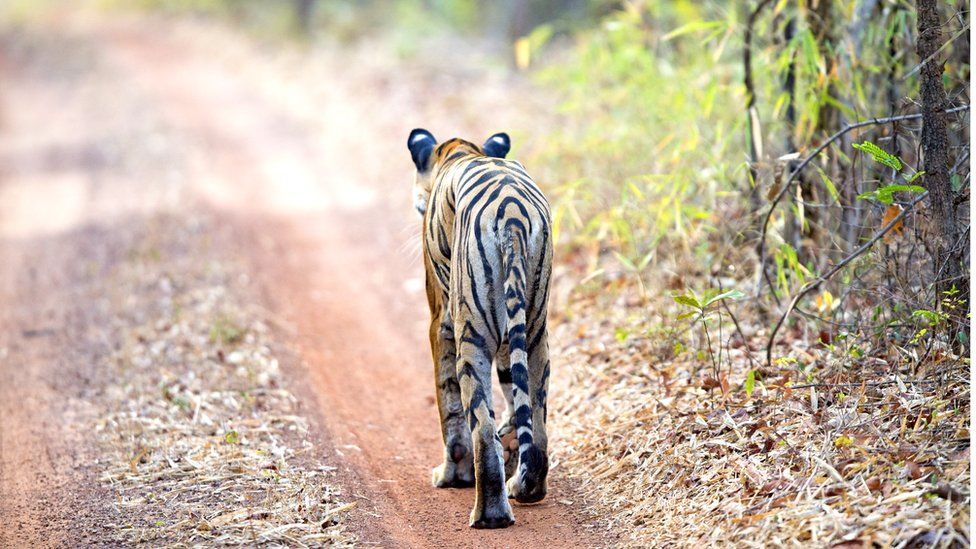How rangers are using AI to help protect India's tigers in 2022

India has around 3,000 tigers
For 22 years vet, Akhilesh Mishra has been treating animals at Pench National Park in Madhya Pradesh state in India.
He does not hesitate to name the tiger as his favourite animal. "They are so magnificent and beautiful. I just need to feel their soft skin to feel relaxed" he says. "!When I treat an injured tiger and then they are able to go back to forest, it is an out of this world experience."
A tiger's life is not easy, he says, particularly for the females: "For me the tigress is much stronger than the male tiger. She fights so fearlessly for her cubs. She is a goddess - ready to take on a huge tiger who tries to harm her cubs."
The tigers he treats have mostly been injured while hunting, or protecting their cubs. But he has also treated tigers that have been poisoned by poachers - who put toxins in pools where they are known to drink.
"My heart cries when I see for no fault theirs, they are killed for their skin, nails and teeth," he says.

Akhilesh Mishra (left) has been treating animals at Pench National Park for 22 years
Protecting India's tigers is an enormous job: most of the tiger population, which in 2018 stood at almost 3,000, live in one of the 51 tiger reserves, covering almost 74,000 square kilometres.
Just estimating the total tiger population is a daunting task.
To carry out its most recent survey, India's National Tiger Conservation Authority (NTCA) deployed camera traps in 26,838 locations, taking 34,858,623 images of wildlife.
On top of that, researchers covered hundreds of thousands of kilometres on foot, looking for signs of tigers and their prey.
To wade through all that data the NTCA used artificial intelligence (AI), which had been trained to recognise different animals.
In the 2018 survey, AI helped by identifying which animals were pictured by the camera traps - a task which would have been very laborious for humans.
Now the NTCA hopes to take the use of AI to another level. A new system is being developed which can give rangers the best routes for patrolling the vast areas under their watch.

AI is being developed which will help rangers optimise their routes
It does that by analysing data about the tiger population, how it moves, and the local topography.
"Artificial intelligence will help rangers in detecting wildlife crimes," predicts Mohmad Sajid Sultan, assistant inspector general, at the NTCA.
While more technology is good to have, those working in conservation say it can't replace boots on the ground.
Tiger conservation has been successful in protected parks, but tigers outside there areas remain "extremely vulnerable", according to environmentalist Debi Goenka.
"Unless we are able to expand our protected area network and our wildlife corridors, the tiger population is not likely to increase," he says.
Mr Goenka says that more human patrols are needed that are better equipped.
"What is really needed is more field patrolling and better use of technology for monitoring and protection. The use of drones, camera traps, real-time tracking of poachers, and use of metal detectors for locating snares and traps needs to be increased and intensified," he adds.
That careful monitoring is more crucial than ever, as tigers and humans come into closer proximity.

Tigers are vulnerable if they roam between protected areas
Sunil Limaye, is the chief forest conservator for Tadaoba National Park in Maharashtra. He says that tiger numbers in his state have increased from 312 to 400 over the last four years.
But as the tiger population has grown, so has its contact with humans, particularly as the local population is encroaching on the forests where tigers live and hunt.
"Predation of livestock and attacks on human beings has led to a negative perception about tigers," he says.
Tigers are particularly vulnerable when they move from one forested area to another, says Mr Limaye. He hopes that AI can come in to play here and help predict the movement of tigers at the forest periphery.
But human rangers will still be needed. "It is still not possible for AI to replace human intelligence," says Mr Limaye.
Jerryl Banait, chairman of AVI Foundation, points out that poachers have also become more sophisticated. They map the patrol routes of rangers, avoid regular trails and know where cameras are located.

As tiger numbers increase, they are more likely to come into contact with humans
His organisation has developed an artificial intelligence which can use the data collected by cameras and rangers, but in addition uses data gathered from satellites and information collected from the local population.
He hopes that forest departments across India will use this more sophisticated hybrid technology to better protect wildlife, particularly animals that are outside National Parks and wildlife sanctuaries in the future.
"With the limited territories available for the wild animals, it is of paramount importance that there is no human interference in the already shrunk wildlife habitats," he says.
Back at Pench National Park, Akhilesh Mishra hopes conservation work can prevent tragedies like the death of one well-known tiger - Baghin nala tigress.
The 12-year-old animal was found dead in March 2016 in the Pench Tiger Reserve, after being poisoned along with two of her cubs.
Mr Mishra managed to rescue a third cub, which has thrived in the reserve and now has cubs of its own: "It was a sight of joy when we brought her up in captivity, developing her hunting skills to survive in the harsh forest."




Recent comments